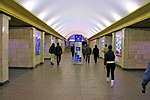Stone Bridge (Saint Petersburg)
Bridges completed in 1778Bridges in Saint Petersburg

The Stone Bridge (Russian: Каменный мост) is a bridge across the Griboyedov Canal in Saint Petersburg, Russia. It was built in 1774–78, and at the time it was one of the first bridges in Saint Petersburg made of stone, hence the name. The bridge crosses the canal on the axis of Gorokhovaya Street connecting Kazansky and Spassky islands. Unlike many other bridges, this one did not undergo major reconstruction, and therefore preserves most of its original form from the 18th century.
Excerpt from the Wikipedia article Stone Bridge (Saint Petersburg) (License: CC BY-SA 3.0, Authors, Images).Stone Bridge (Saint Petersburg)
Griboyedov Channel Embankment, Saint Petersburg
Geographical coordinates (GPS) Address External links Nearby Places Show on map
Geographical coordinates (GPS)
| Latitude | Longitude |
|---|---|
| N 59.9305 ° | E 30.319 ° |
Address
Каменный мост
Griboyedov Channel Embankment
190031 Saint Petersburg (Сенной округ)
Saint Petersburg, Russia
Open on Google Maps











